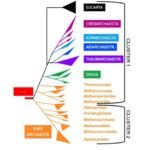Lien vers Pubmed [PMID] – 25124552
BMC Genomics 2014;15:679
BACKGROUND: A seventh order of methanogens, the Methanomassiliicoccales, has been identified in diverse anaerobic environments including the gastrointestinal tracts (GIT) of humans and other animals and may contribute significantly to methane emission and global warming. Methanomassiliicoccales are phylogenetically distant from all other orders of methanogens and belong to a large evolutionary branch composed by lineages of non-methanogenic archaea such as Thermoplasmatales, the Deep Hydrothermal Vent Euryarchaeota-2 (DHVE-2, Aciduliprofundum boonei) and the Marine Group-II (MG-II). To better understand this new order and its relationship to other archaea, we manually curated and extensively compared the genome sequences of three Methanomassiliicoccales representatives derived from human GIT microbiota, “Candidatus Methanomethylophilus alvus”, “Candidatus Methanomassiliicoccus intestinalis” and Methanomassiliicoccus luminyensis.
RESULTS: Comparative analyses revealed atypical features, such as the scattering of the ribosomal RNA genes in the genome and the absence of eukaryotic-like histone gene otherwise present in most of Euryarchaeota genomes. Previously identified in Thermoplasmatales genomes, these features are presently extended to several completely sequenced genomes of this large evolutionary branch, including MG-II and DHVE2. The three Methanomassiliicoccales genomes share a unique composition of genes involved in energy conservation suggesting an original combination of two main energy conservation processes previously described in other methanogens. They also display substantial differences with each other, such as their codon usage, the nature and origin of their CRISPRs systems and the genes possibly involved in particular environmental adaptations. The genome of M. luminyensis encodes several features to thrive in soil and sediment conditions suggesting its larger environmental distribution than GIT. Conversely, “Ca. M. alvus” and “Ca. M. intestinalis” do not present these features and could be more restricted and specialized on GIT. Prediction of the amber codon usage, either as a termination signal of translation or coding for pyrrolysine revealed contrasted patterns among the three genomes and suggests a different handling of the Pyl-encoding capacity.
CONCLUSIONS: This study represents the first insights into the genomic organization and metabolic traits of the seventh order of methanogens. It suggests contrasted evolutionary history among the three analyzed Methanomassiliicoccales representatives and provides information on conserved characteristics among the overall methanogens and among Thermoplasmata.


